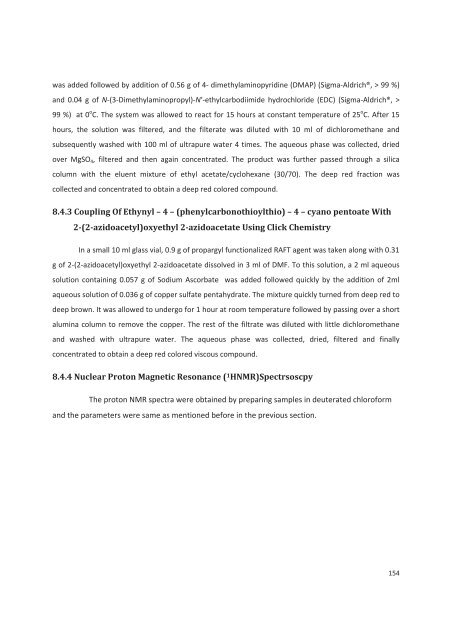4(%3)3 - Ecole nationale supérieure de chimie de Montpellier
4(%3)3 - Ecole nationale supérieure de chimie de Montpellier
4(%3)3 - Ecole nationale supérieure de chimie de Montpellier
Create successful ePaper yourself
Turn your PDF publications into a flip-book with our unique Google optimized e-Paper software.
was ad<strong>de</strong>d followed by addition of 0.56 g of 4- dimethylaminopyridine (DMAP) (Sigma-Aldrich®, > 99 %)and 0.04 g of N-(3-Dimethylaminopropyl)-N-ethylcarbodiimi<strong>de</strong> hydrochlori<strong>de</strong> (EDC) (Sigma-Aldrich®, >99 %) at 0 o C. The system was allowed to react for 15 hours at constant temperature of 25 o C. After 15hours, the solution was filtered, and the filterate was diluted with 10 ml of dichloromethane andsubsequently washed with 100 ml of ultrapure water 4 times. The aqueous phase was collected, driedover MgSO 4 , filtered and then again concentrated. The product was further passed through a silicacolumn with the eluent mixture of ethyl acetate/cyclohexane (30/70). The <strong>de</strong>ep red fraction wascollected and concentrated to obtain a <strong>de</strong>ep red colored compound.8.4.3 Coupling Of Ethynyl – 4 – (phenylcarbonothioylthio) – 4 – cyano pentoate With2-(2-azidoacetyl)oxyethyl 2-azidoacetate Using Click ChemistryIn a small 10 ml glass vial, 0.9 g of propargyl functionalized RAFT agent was taken along with 0.31g of 2-(2-azidoacetyl)oxyethyl 2-azidoacetate dissolved in 3 ml of DMF. To this solution, a 2 ml aqueoussolution containing 0.057 g of Sodium Ascorbate was ad<strong>de</strong>d followed quickly by the addition of 2mlaqueous solution of 0.036 g of copper sulfate pentahydrate. The mixture quickly turned from <strong>de</strong>ep red to<strong>de</strong>ep brown. It was allowed to un<strong>de</strong>rgo for 1 hour at room temperature followed by passing over a shortalumina column to remove the copper. The rest of the filtrate was diluted with little dichloromethaneand washed with ultrapure water. The aqueous phase was collected, dried, filtered and finallyconcentrated to obtain a <strong>de</strong>ep red colored viscous compound.8.4.4 Nuclear Proton Magnetic Resonance ( 1 HNMR)SpectrsoscpyThe proton NMR spectra were obtained by preparing samples in <strong>de</strong>uterated chloroformand the parameters were same as mentioned before in the previous section.154











